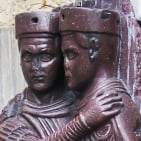A little curiosity about two German ligatures
Options

mauro sacchetto
Posts: 353
It is known that in German the pair <ch> and <ck> must not be separated.
With the 1996 spelling reform, we no longer accept that <ck> can be separated (becoming <k | k>).
Now, knowing that the settings of the various programs should follow these rules (for example the hyphenation patterns for LaTeX), some fonts have ligatures <ch> and <ck>.
In some fonts Adobe puts them in a special dlig lookup (adding that I don't know how to do it, composing with LaTeX and also having other dlig, to activate only this one; but this is not a problem pertaining to this forum).
Now: is it more logical to put them precisely as dlig (with which they are optional) or as a liga, specifying in the metadata that only applies to German? Or in some other way (locl or calt with a contextual substitution rule)?
With the 1996 spelling reform, we no longer accept that <ck> can be separated (becoming <k | k>).
Now, knowing that the settings of the various programs should follow these rules (for example the hyphenation patterns for LaTeX), some fonts have ligatures <ch> and <ck>.
In some fonts Adobe puts them in a special dlig lookup (adding that I don't know how to do it, composing with LaTeX and also having other dlig, to activate only this one; but this is not a problem pertaining to this forum).
Now: is it more logical to put them precisely as dlig (with which they are optional) or as a liga, specifying in the metadata that only applies to German? Or in some other way (locl or calt with a contextual substitution rule)?
0
Comments
-
https://typedrawers.com/discussion/2755/if-you-know-special-local-kerning-cases-post-them-here-please#latest
Not sure about the technical stuff, but at the bottom of thread is what i was able to find.
0 -
dligis meant for Discretionary Ligatures, ligatures that are purely for a special effect:Function: Replaces a sequence of glyphs with a single glyph which is preferred for typographic purposes. This feature covers those ligatures which may be used for special effect, at the user’s preference.(https://docs.microsoft.com/en-us/typography/opentype/spec/features_ae#dlig), while
[..]
UI suggestion: This feature should be off by default.ligais for "common" ligatures only:Function: Replaces a sequence of glyphs with a single glyph which is preferred for typographic purposes. This feature covers the ligatures which the designer/manufacturer judges should be used in normal conditions.(https://docs.microsoft.com/en-us/typography/opentype/spec/features_ko#tag-liga)
[..]
UI suggestion: This feature serves a critical function in some contexts, and should be active by default.
Bold emphasis is mine.
The "special effect" can be seen in this image of Warnock Pro (https://helpx.adobe.com/nl/fonts/using/open-type-syntax.html#dlig):
Not separating <ck> and <ch> is a function of the text engine, not of the font, so I would not try to force this inlocl. I would only recommend this if your own /ck and /ch are unobtrusive enough to use in 'regular' text, but if not, they belong indlig, to be used at the user's discretion.
1 -
Ok, I put those legatures in to 'dlig'.
And -- if 'm not wrong -- in 'dpng' some old ligatures as <a_e> (æ) and <o_e> (œ) used in Chistian Latin, for they sound like a single vowel, while in classical Latin (that of the so-called "lectio restituta") diphthongs are pronounced open, and therefore with the two distinct vowels).0 -
'dpng' is a deprecated feature which shouldn't be used. Æ and Œ are separate characters and shouldn't be handled by OpenType features.3
-
So, <æ> <œ> but even <ij> must not be considered as small ligatures?0
-
I can’t comment on <ij> since I am not particularly familiar with Dutch. But æ and œ should definitely not be considered as ligatures. These represent distinct letters in e.g. French (for œ) and Icelandic (for æ). In English these are occasionally used as optional ligatures in words like encyclopædia or œsophagus, but this is restricted to specific words of graeco-roman origins and cannot be used generally (e.g. in words like ‘nae’ or ‘faerie’.
Also, it should be noted that these ligatures never actually existed in classical Latin — their use in Latin text was a mediaeval invention but I doubt it was tied to any changes in latin pronunciation between classical latin and church latin. Æ (‘æsc’) was originally an Old English letter which was not viewed as a diphthong or digraph. I don’t know the origins of œ (‘œthel’) but it definitely wasn't Latin.
2
Categories
- All Categories
- 46 Introductions
- 3.8K Typeface Design
- 476 Type Design Critiques
- 556 Type Design Software
- 1.1K Type Design Technique & Theory
- 640 Type Business
- 831 Font Technology
- 29 Punchcutting
- 508 Typography
- 120 Type Education
- 313 Type History
- 75 Type Resources
- 110 Lettering and Calligraphy
- 31 Lettering Critiques
- 79 Lettering Technique & Theory
- 533 Announcements
- 86 Events
- 110 Job Postings
- 167 Type Releases
- 169 Miscellaneous News
- 274 About TypeDrawers
- 53 TypeDrawers Announcements
- 119 Suggestions and Bug Reports


